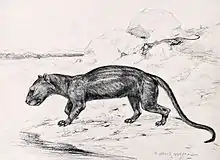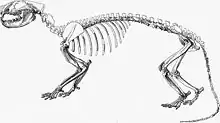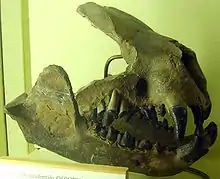Oxyaena
Oxyaena ("sharp" or "drawn-out" + hyena) is an extinct genus of oxyaenid mammal from the latest Paleocene to early Eocene of North America (most specimens being found in Colorado). The species were superficially cat or wolverine-like, with a flexible body 1 metre (3.3 ft) long, and short limbs. Some species like Oxyaena forcipata were bigger with a body mass estimated to be 20 kg.[1]

| Oxyaena | |
|---|---|
 | |
| Oxyaena lupina skeletal restoration | |
| Scientific classification | |
| Kingdom: | Animalia |
| Phylum: | Chordata |
| Class: | Mammalia |
| Order: | †Oxyaenodonta |
| Family: | †Oxyaenidae |
| Subfamily: | †Oxyaeninae |
| Genus: | †Oxyaena Cope, 1874 |
| Type species | |
| Oxyaena lupina Cope, 1874 | |
| Species | |
| |
Oxyaena had a broad, low skull (20 cm. long) with a long facial part and a massive lower jaw, while its body and tail were long and its five-toed limbs were short.
The oxyaenid family of mammals takes its name from this genus. Oxyaenids may have evolved in North or Central America, and tended to have long bodies and tails with short legs. Because of their shape, early studies often compared them to cats, but this body form has evolved many times in small- to medium-sized forest-dwelling predators and mixed feeders, such as viverrids, mustelids, and procyonids. Oxyaena and its relatives are creodonts, an extinct order of meat-eating mammals with no close living relatives.[2]
Oxyaena species were plantigrade, treading on the whole surface of their soles. For this reason, these animals could not have specialized in chasing down fast-running prey. Early studies disagreed on whether they were walking, climbing, or swimming animals; more recent work suggests that like modern raccoons, they may have been able to climb trees, swim, and make a living on the ground, but were not highly specialized in any direction.[3] An analysis of the teeth shows they were generalized feeders, like most modern raccoons and bears, rather than hypercarnivores like modern cats. The overall shape of the feeding equipment in Oxyaena was most similar to the Pleistocene bear Arctodus, which has been reconstructed as eating a range of foods similar to modern brown bears, with a preference for meat.[4] Oxyaena species had a similar size range as modern otters, so they would have hunted small to medium-sized prey, as well as eating some other foods such as insects, crustaceans, and fruit.
In the early Eocene of Wyoming, Oxyaena lived among early rodents, a variety of lemur-like tree-dwellers, pantodonts, and early relatives of horses and tapirs, as well as many other small- to mid-sized predators and mixed feeders, including aquatic species (Paleosinopa). The fossil evidence shows that at least in Wyoming, Oxyaena lived in forests or along the margins of forest lakes and streams, and was flexible enough in its habits to survive significant changes in the environment.[5]
References
- Gunnell, Gregg F., and Philip D. Gingerich. "Systematics and evolution of late Paleocene and early Eocene Oxyaenidae (Mammalia, Creodonta) in the Clarks Fork basin, Wyoming." (1991).
- Gingerich, Philip D. (1980). "Tytthaena parrisi, Oldest Known Oxyaenid (Mammalia, Creodonta) from the Late Paleocene of Western North America". Journal of Paleontology. 54 (3): 570–576. ISSN 0022-3360.
- Gebo, Daniel L.; Rose, Kenneeth D. (1993). "Skeletal Morphology and Locomotor Adaptation in Prolimnocyon atavus, an Early Eocene Hyaenodontid Creodont". Journal of Vertebrate Paleontology. 13 (1): 125–144. ISSN 0272-4634.
- Wesley-Hunt, Gina D. (2005). "The Morphological Diversification of Carnivores in North America". Paleobiology. 31 (1): 35–55. ISSN 0094-8373.
- Chew, Amy E. (2009). "Paleoecology of the Early Eocene Willwood Mammal Fauna from the Central Bighorn Basin, Wyoming". Paleobiology. 35 (1): 13–31. ISSN 0094-8373.
- Benes, Josef. Prehistoric Animals and Plants. Pg. 203. Prague: Artia, 1979.
- Gunnell, Gregg F., and Philip D. Gingerich. "Systematics and evolution of late Paleocene and early Eocene Oxyaenidae (Mammalia, Creodonta) in the Clarks Fork basin, Wyoming." (1991).
